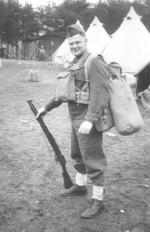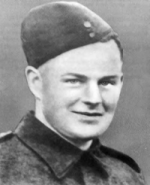John Molyneax “Red” Fisher was born in Sarnia, Ontario in 1913. After leaving Sarnia Collegiate Institute and Technical School, he spent a year as a riveter for Imperial Oil before becoming a tinsmith for Howard Mundy Hardware. He enlisted in the Royal Canadian Engineers with his brother Earl "Bill" Fisher in Sarnia on 5 September 1939. He was assigned to the 1stField Park Company and was initially employed on furnace installations in newly built Army buildings, a job he had learned as a tinsmith.
Red likely trained locally with his unit and then later moved on the Camp Petawawa for more advanced trades training. He embarked from Saint John, NB on 1 December 1940. The advance elements of the 1st Fd Park Coy had embarked earlier, so with this draft, the 2nd Canadian Division was now complete in England. Like the rest of the 2nd Division engineer units, the 1stField Park Company was busy in south-east England with construction projects, preparing defensive works and training. He had been promoted to Lance Corporal on 1 August 1940, but reverted to Sapper at his own request on 11 April 1941, only to be promoted again on 1 March 1942 as the unit prepared for Operation RUTTER which is the rank he held for Operation JUBILEE.
Red landed with L/Sgt GA Hickson’s party on WHITE BEACH with the task of destroying the telephone exchange and safe in the main post office in the town of Dieppe and then destroy a torpedo dump at the east cliff. The assaulting troops took intense fire from what seemed like all sides and he almost immediately received a shrapnel wound in his right foot. L/Sgt Hickson ordered him out of action and back to the landing craft. L/Sgt Hickson took command of the escorting infantry platoon (its officer and sergeant were put out of action), and with the remaining sappers, got across the beach and esplanade to the Casino where they were held down, but were nonetheless able to wreak havoc on the German defenders as is told in Sgt Hickson's tribute.
Red did not stay put as directed. With Spr Huyck, he made his way to the Casino. On their way, they destroyed a heavily-armed pill box covering the beach with explosives. Newspaper accounts of the event added that they killed the gunners in hand to hand combat. Once at the Casino, they re-joined the Hickson party which by this time was a handful of infantrymen and one Spr Price. The official history of the Royal Canadian Engineers makes perhaps light of what happened next, “the four surviving sappers had a field day blowing in sniper’s nests and cutting through walls with small prepared charges.” In fact, the struggle was harsh and costly.
L/Sgt Hickson sent Red and Spr Huyck to make their way to the telephone exchange, while he planned to get there by another route. Fisher and Huyck got as far as the tobacco factory just off the promenade and set it on fire. They were then forced back to the Casino where they worked hard in the evacuation of the wounded and destroyed the remaining demolition packs in the building. For these actions, he was awarded the Military Medal that was presented by King George VI at Buckingham Palace on 7 November 1942.
After recovering from 60 days in hospital, Red re-joined the 1st Field Park Company as they prepared for his second trip to France that would come later in 1944. His spirited nature continued to show as he spent time in detention, forfeited pay and was confined to barracks from time to time. None of this seems to have affected his ability to fight and complete sapper tasks. He landed in Normandy with his company and spent 34 days there before he was wounded by machine gun burst in the leg during the Operation TOTALIZE on the 'Road to Falaise'. He was subsequently hospitalized for 255 days in England.
While Red was in hospital the first time, he met an English nurse, Mary O'Shea, and they married in 1943. Mary came to Canada in 1944 in an unescorted ship filled with other war brides and gave birth to their first son in October of that year. From the time of his wounding, Red spent over eight more months in an English hospital before returning to Canada for further recovery on 25 April 1945. He remained in the Army until he was discharged on 25 June 1945.
Red continued to work as a tinsmith and was employed by the Polymer Corporation in Sarnia from the time he returned. He also installed furnaces in homes part-time until his sudden death at the young age of 42 years on 28 January 1955. It is thought that the continuing infections Red suffered as a result of his wounds contributed to his death. Red was an active member of the Sarnia Garrison and a member of the Sergeants Mess. When he died, he was given a military funeral and was honoured with Last Drumhead Service by the Sarnia Garrison.
Immediately upon landing with Lance-Sergeant Hickson's party, Fisher was wounded in the foot and ordered out of action, but later took a Sapper and tried to get into Dieppe. With PHE charges he destroyed a machine gun position, killing the personnel. Unable to proceed because of heavy enemy fire, he returned to the machine gun position when he met an infantry officer with a large number of Sticky Bombs. These were carried forward and placed against the wall of a building on the Esplanade. Fisher detonated them all, setting the partly ruined building on fire. Returning to the Casino he organized returning Royal Canadian Engineer personnel for evacuating and destroying the remaining demolition packs in the building. During the whole operation Lance-Corporal Fisher was an inspiration to all by his display of personal bravery and initiative although wounded.


